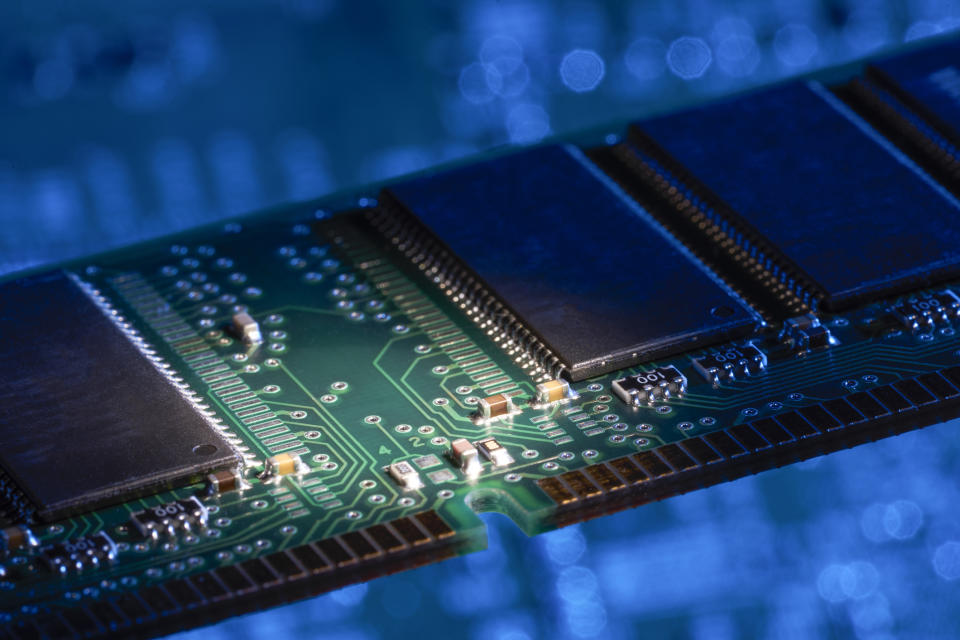Better Buy: Seagate Technology vs. Micron
Seagate (NASDAQ: STX) and Micron (NASDAQ: MU) both provide key components for PCs and other devices. Seagate is the world's second largest maker of traditional HDDs (hard disk drives), and Micron is the third largest producer of DRAM and NAND memory chips.
Both companies faced similar headwinds over the past year. Sluggish PC sales, exacerbated by Intel's (NASDAQ: INTC) chip shortage, throttled demand for their components, and softer spending from data center operators caused additional headaches.

Image source: Getty Images.
Seagate also struggled with competition from NAND-based SSDs (solid state drives), which were faster, smaller, more power-efficient, and less prone to damage than HDDs. SSDs are pricier than HDDs, but lower memory prices reduced that gap. Lower prices of NAND and DRAM chips also gutted Micron's core business, which sells those chips to the PC, data center, mobile, and IoT markets.
However, Seagate's stock rallied about 20% this year, while Micron's surged 40% -- which might surprise some investors, since both companies have reported negative sales growth over the past few quarters. Let's see why these stocks rallied, and if either is a worthy buy.
The key differences between Seagate and Micron
Seagate's bigger rival Western Digital (NASDAQ: WDC) became one of the top producers of NAND chips and SSDs in the world after it acquired SanDisk in 2016. Seagate, however, mainly stuck with HDDs, which generated 92% of its sales during its third quarter (which ended on March 29).
To counter competition from SSDs in consumer devices, Seagate pivoted away from smaller HDDs (those with capacities of 1TB and below) and focused on selling higher-capacity drives for desktops, workstations, and data centers. Last quarter Seagate generated 39% of its sales from the enterprise market, 32% from the non-PC consumer electronics market, and 20% from PCs.
Micron generated 64% of its sales from DRAM chips and 31% from NAND chips during its third quarter (which ended on May 30). That makes it more of a "pure play" on the cyclical memory chip market than Samsung (OTC: SSNLF), which leads the DRAM and NAND markets but also generates revenue from other businesses.

Image source: Getty Images.
As a result, Micron's sales are tightly tethered to market prices for memory chips. Unfortunately, prices for both types of chips peaked last year due to sluggish PC sales, the saturation of the smartphone market, and cloud service providers pausing their big data center upgrades. Micron doesn't expect those prices to rebound until 2020.
Which company is closer to a cyclical bottom?
Seagate and Micron both posted negative sales growth over the past two quarters, due to the aforementioned headwinds.
YOY revenue growth | Q3 2018 | Q4 2018 | Q1 2019 | Q2 2019 | Q3 2019 |
|---|---|---|---|---|---|
Seagate | 5% | 18% | 14% | (7%) | (17%) |
Micron | 40% | 38% | 16% | (21%) | (39%) |
YOY = Year-over-year. Source: Company quarterly reports.
Both companies are also struggling with contracting gross margins. Seagate is losing pricing power for its HDDs amid sluggish demand and competition from cheaper SSDs, while prices for Micron's DRAM and NAND chips remain in freefall.
Gross margin* | Q3 2018 | Q4 2018 | Q1 2019 | Q2 2019 | Q3 2019 |
|---|---|---|---|---|---|
Seagate | 31% | 32% | 31% | 30% | 27% |
Micron | 61% | 61% | 59% | 50% | 39% |
Source: Company quarterly reports. *Non-GAAP, rounded.
Seagate expects it fourth-quarter revenue to decline 18% annually, but that would represent roughly flat growth from the third quarter. It expects its non-GAAP gross margin to be "at least" 26.5%, compared to 26.6% in the third quarter.
Micron expects its fourth-quarter revenue to plunge 47% annually and 6% sequentially. It expects its non-GAAP gross margin to contract to about 29%. Those forecasts indicate that Seagate is much closer to a cyclical bottom than Micron.
The winner: Seagate
Seagate also has clearer catalysts on the horizon than Micron. Intel expects to resolve its chip issues by the end of the year, which could lift sales of PCs and HDDs again. The growth of cloud and streaming services will also strain the storage capacities of data centers, which could fuel demand for its higher-capacity data center HDDs. Investors also get paid a forward dividend yield of 5.3% as they await that recovery.
Micron doesn't pay a dividend, and it arguably faces tougher headwinds. The global glut in memory chips won't end anytime soon, and unpredictable factors -- including China's domestic production of DRAM and NAND chips -- could prolong the pain. Micron's declines will eventually bottom out, but Seagate is closer to a turning point -- which makes it a better buy.
More From The Motley Fool
Leo Sun has no position in any of the stocks mentioned. The Motley Fool owns shares of Intel and has the following options: short September 2019 $50 calls on Intel. The Motley Fool has a disclosure policy.
This article was originally published on Fool.com

 Yahoo Finance
Yahoo Finance 